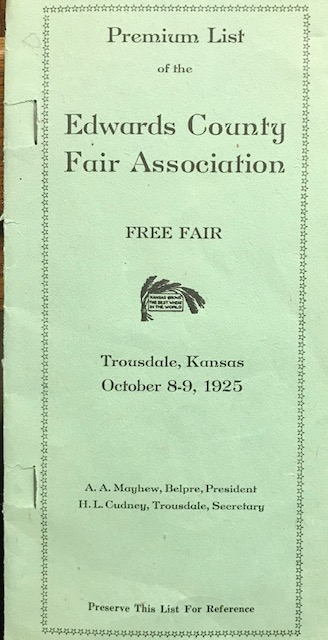The Old Settler’s Picnic, held in June, continued into the 1960s, but it did lose its original purpose of keeping the pioneering stories alive. In 1925, there was renewed interest again in organizing an Edwards County Fair. Trousdale, which was settled in 1915, held community fairs in October of 1923 and 1924. In 1925, after 38 years without a county fair, it was decided to expand the Trousdale fair into a two-day Edwards County Fair.
The Kinsley Mercury reported that “The work in putting on this enterprise was well handled by the live wires at Trousdale” and the fair was a big success. “The poultry show had some of the highest types and strains of birds from all over the state, which added to the interest and keen competition.” There were races of many kinds and ball games on both days.

Image complements of Nancy Bixler, Joy Cudney’s daughter
In 1926 the fair was even bigger and better. Within the agricultural exhibits was a 10-pound sweet potato and tobacco and jumbo peanuts were exhibited. The boys and girls competed in all kinds of races including sack and potato races. Unlike the adult potato races on horseback with lances which was also held, the children merely ran around picking up the scattered potatoes. For the first time, a turtle race was held, and it has often been a popular attraction ever since.
The Trousdale merchants would drive around in decorated cars to advertise the fair in Haviland, Cullison, Byers, Hopewell, Macksville, Belpre, Kinsley, Offerle, Centerview and Fellsburg. 1928 found the fair to be even better than the previous years. Exhibits were praised and cow calling and corn husking contests were added.
However, a county fair is a big undertaking for a small community. “There is no end of work to a proposition of this kind and while the people of Trousdale are not opposed to work, still when it falls on as few as it did there, it was much of a load” (Mercury, Aug. 19, 1929). A meeting was held in August and the consensus was that if a fair was desired, Kinsley would host it, but “they did not want to vote a lot of work on a few willing souls if the fair was not wanted and the proper cooperation could not be had.”
At the beginning of September, it was decided to hold the 1929 county fair on Oct. 31 and Nov. 1 at the Kinsley High School, in the old McLaughlin barn owned by the school and now on the railroad right of way, and at the Flohr Opera House (625 Colony Ave.). Awards were given for cattle, hogs, sheep, and poultry of all kinds. The best samples of wheat, oats, barley, clover, millet, alfalfa, sweet clover seed, various varieties of corn seed and the usual vegetables, canned goods, and baked goods were all judged.
The first night of the fair featured a show of local musical talent and recitations. During the last part of the program, the J.C. Penney company showed their latest fashions in a big style show. That year’s Better Babies contest had 138 entries between the ages of 1 to 5 years. Seven rural school districts as well as the city schools within the county entered exhibits of student work.
In 1932 the 4-H Observance Day was incorporated into the Edwards County Fair. 4-H Clubs reached their peak this year with 13 clubs and 259 members in the county. I imagine the Dust Bowl days influenced the county fair being replaced with 4-H Achievement Day in 1935. In 1941 it would be called the Edwards County 4-H Fair.
An Edwards County Fair would return in 1959 as a supplement to the 4-H fair. Entries were open to all residents of the county and a carnival was employed.
Research done by Cathy Ambler of the University of Kansas and others reveals the following highlights over the years. The grandstand at South Park was constructed in 1934 and today is the second oldest existing grandstand in the state. The first rodeo was held in Kinsley in 1944 and later rodeos were often part of the fair. The stone 4-H livestock barn was built in 1940. The first tractor driving contest was held in 1954. In 1955 there were 813 4-H entries. The boys walked off with both the grand and reserve championships in food preparation in 1956.
Bill MCGaw’s Tournament of Thrills in 1960 featured 12 Ford cars in 40 minutes of precision driving. From 1960 to 1971 American Quarter Horse Shows and Cutting Horse Contests were held and sometimes they would be incorporated into the fair. Loretta Lynn with the Grand Ole Opry entertained here in 1961. The 4-H building was built in 1968 and the Otis Show Arena in 1984. In the 1990s, the Tired Iron Club exhibited old tractors and farm equipment. Carnivals, fireworks, and livestock parades were all fair attractions over the years.
This year will be entered into the annals of history as the 4-H fair that no one could attend. We still want to congratulate all the 4-H participants who competed and took home ribbons. Hopefully, next year the pandemic will be under control and the community can again come together for a real, fun-filled county fair.
